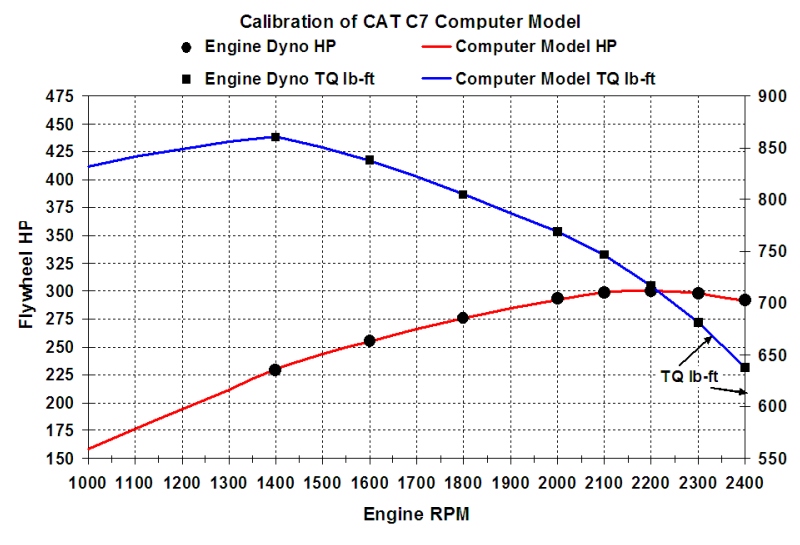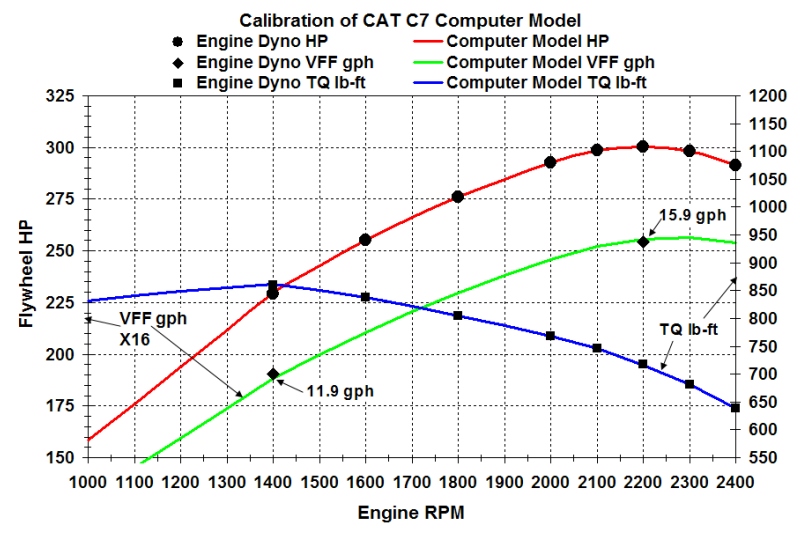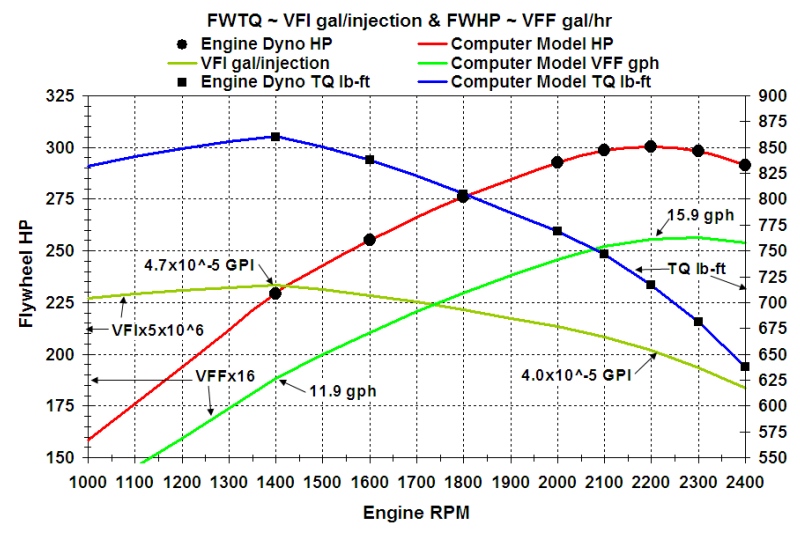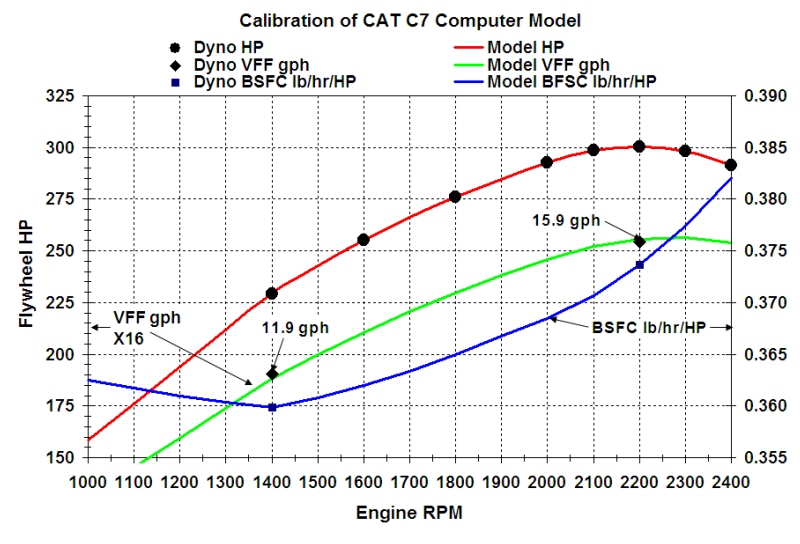What is the 7.3's "sweet spot" ??
#31
Maybe I missed it, but in addition to all that there is another consideration. Bigger tires usually = more rotational weight. And the weight has a larger circumference. There's all kinds of information out there as to rotational weight vs sprung weight. Anywhere from 1 pound of rotational weight = 5-10 pounds of sprung weight.
It all adds up.
It all adds up.
#32
For those who are curious....
I did some data logging to see how the numbers come out.
All figures are in top gear with TC locked. Stock tune, stock tires. Terrain was relatively flat. The data was purged for inclines and declines before the numbers were averaged. I will be happy to send the data log if anyone is interested in evaluating the readings themselves. (I am still learning how to use my AE as well...)
I monitored vehicle speed, rpm and volume fuel desired (mm3). The following numbers are averages for the given length of time listed.
Speed=57.3 RPM=1595 VFD=18.8 Time=33sec
Speed=60.6 RPM=1688 VFD=20.3 Time=53sec
Speed=61.3 RPM=1712 VFD=18.1 Time=33sec
Speed=64.7 RPM=1803 VFD=19.2 Time=20sec
Speed=64.9 RPM=1809 VFD=21.8 Time=60sec
Speed=66.0 RPM=1844 VFD=22.9 Time=26sec
Speed=70.6 RPM=1975 VFD=27.7 Time=22sec
I did some data logging to see how the numbers come out.
All figures are in top gear with TC locked. Stock tune, stock tires. Terrain was relatively flat. The data was purged for inclines and declines before the numbers were averaged. I will be happy to send the data log if anyone is interested in evaluating the readings themselves. (I am still learning how to use my AE as well...)
I monitored vehicle speed, rpm and volume fuel desired (mm3). The following numbers are averages for the given length of time listed.
Speed=57.3 RPM=1595 VFD=18.8 Time=33sec
Speed=60.6 RPM=1688 VFD=20.3 Time=53sec
Speed=61.3 RPM=1712 VFD=18.1 Time=33sec
Speed=64.7 RPM=1803 VFD=19.2 Time=20sec
Speed=64.9 RPM=1809 VFD=21.8 Time=60sec
Speed=66.0 RPM=1844 VFD=22.9 Time=26sec
Speed=70.6 RPM=1975 VFD=27.7 Time=22sec
I define the VFI=Volume Fuel Injected gal/inj as the gal volume of fuel that's injected into the cylinders to produce each power stroke. For each cylinder a power stroke occurs once every 2 revolutions of the crankshaft ...so there's an injection of VFI gal of fuel into each cylinder once every 2 revolutions of the crankshaft ...and for an engine with Nc cylinders operating at a given RPM ...this gives a total VFF=Volume Fuel Flow gal/hr equal to... VFF={(30)(Nc)(VFI)(RPM)} gal/hr or GPH.
The U.S. liquid gallon is defined as 231 in^3 ...and there's 25.4 mm/in ...so there's 16,387 mm^3/in^3 ...which gives 3.79x10^6 mm^3/gal ...and 2.64x10^-7 gal/mm^3 ...so I need to multiply your measured VFD mm^3/inj by 2.64x10^-7 gal/mm^3 to convert your VFD mm^3/inj to my VFI gal/inj.
Then I can use your measured RPM versus VFD to calculate the GPH from... GPH={(30)(Nc)(VFI)(RPM)} gal/hr ...and then use your measured MPH to calculate the MPG from... MPG=(MPH)/(GPH) ...and then compare your measured MPG to what I'll now call the MPG* that's predicted by using my "simplified" equation... GPH*= {0.5}+{(MPH)/(100)}+{(MPH^3)/(100,000)} gal/hr ...to calculate the GPH* corresponding to your measured MPH ...and then calculate the MPG* using... MPG*=(MPH)/(GPH*) ...and below is your table with these additions...
MPH=60.6 RPM=1688 VFD=20.3 VFI=5.36x10^-6 gal/inj GPH=2.17 gal/hr MPG=27.9 vs MPG*=18.2
MPH=61.3 RPM=1712 VFD=18.1 VFI=4.78x10^-6 gal/inj GPH=1.96 gal/hr MPG=31.3 vs MPG*=17.9
MPH=64.7 RPM=1803 VFD=19.2 VFI=5.07x10^-6 gal/inj GPH=2.19 gal/hr MPG=29.5 vs MPG*=16.8
MPH=64.9 RPM=1809 VFD=21.8 VFI=5.76x10^-6 gal/inj GPH=2.50 gal/hr MPG=26.0 vs MPG*=16.7
MPH=66.0 RPM=1844 VFD=22.9 VFI=6.05x10^-6 gal/inj GPH=2.68 gal/hr MPG=24.6 vs MPG*=16.4
MPH=70.6 RPM=1975 VFD=27.7 VFI=7.31x10^-6 gal/inj GPH=3.47 gal/hr MPG=20.3 vs MPG*=14.9
Well based on the last two columns in the above table ...which compare your measured MPG to the MPG* that's predicted using my "simplified" equation ...I'm sure that everyone wishes the VFD actually was the volume of fuel that's injected into the cylinders to produce each power stroke ...but based on the actual MPG achieved from one fill up to the next the VFD must be something other than the amount of fuel that's injected ...and that begs the question as to just what VFD is ...where does it come from ...and how does the ECM calculate and/or use the VFD???
#33
The above might illustrate theoretical mpg changes with the speed but those have little practical use unless you are driving on roads with no traffic and no stop signs.
I played with pretty accurate computer on Mercedes sedan. I could achieve over 42 mpg at 80 mph on empty freeways in Nebraska or Wyoming.
When I had to deal with left line idiots in California at those speeds the practical mpg dropped to 32-36 mpg.
On trucks front wind at high speeds can cut the mpg by as much as 20%.
I have common situation driving south in California giving me always better mpg than driving North due the winds.
I played with pretty accurate computer on Mercedes sedan. I could achieve over 42 mpg at 80 mph on empty freeways in Nebraska or Wyoming.
When I had to deal with left line idiots in California at those speeds the practical mpg dropped to 32-36 mpg.
On trucks front wind at high speeds can cut the mpg by as much as 20%.
I have common situation driving south in California giving me always better mpg than driving North due the winds.
#34
Well based on the last two columns in the above table ...which compare your measured MPG to the MPG* that's predicted using my "simplified" equation ...I'm sure that everyone wishes the VFD actually was the volume of fuel that's injected into the cylinders to produce each power stroke ...but based on the actual MPG achieved from one fill up to the next the VFD must be something other than the amount of fuel that's injected ...and that begs the question as to just what VFD is ...where does it come from ...and how does the ECM calculate and/or use the VFD???
Based on your analysis, it appears to me the calculated VFD might actually be pretty close to volume of fuel injected because one must keep in mind that I started the data log from a flying start so the fuel used to accelerate through the gears to the chosen speed was not part of the equation. Additionally, I did not include the fuel used to change to the next speed range. I attempted to drive at a steady 55mph for 10 to 20 seconds, then I accelerated to 60 mph for a while and so on. I then purged the data for the speed changes and segregated them into the groups listed in my post. I then averaged the figures and rounded the result to the nearest tenth for simplification.
The purpose of this particular data capture was to see if there is indeed any sort of 'sweet spot' in respect to fuel usage at a certain speed or rpm. So for this exercise, a calculated VFD will serve our purposes. It's not necessarily the ACTUAL MPG but instead the relationship and percentage of change that shows if the engine is using more or less fuel that matters. To me, the data shows there may be a sweet spot around the 1700 rpm range. Doesn't your predicted MPG model show something similar?
Thank you for taking the time to analyze this data and provide your detailed calculation methods. It's always very enlightening (and sometimes daunting) to attempt to follow along with your calculations and explanations. At a minimum, your analysis appears to show that VFD has some sort of relationship to actual measured MPG even if it is not exactly accurate. Perhaps the variance is related to how I compiled the data summary? Would you like the actual data file? You then could see the Speed, RPM and VFD for each time sample and you may be able to calculate the MPG for each segment and then average that column of data for a more accurate analysis. If so, PM me and I'll send it over to you.
Interesting topic.
#36
imagination needed momentarily:

Imagine that the smaller gear is way bigger, maybe turns 1.2-1.5 times for every revolution of the big one.
Now, picture this assembly between your engine and tranny. Bigger one on the engine shaft, smaller on the tranny.
The input shaft on the tranny would now turn 1.2-1.5 times per engine revolution. This would reduce the stress on the transmission. Other overdrive products increase it.
This could allow you to cruise at 80mph @ 1900 rpm's if you wanted. Without killing tranny.
It could also allow a guy to have 4.10's and still run 1600-2000 rpm's down the highway.
my .02$
#37
My 4.88 differential allows me to take 6% grades on 6th gear with 7,000 lb payload.
It calls for overdrive, but per my experience overdrive will not give you significant savings. Maybe 5% at the best. F450 have no choice of different differentials.
Meaning you can install gear vendor, but than you will have to drive the truck for 2 million miles to get your money back on fuel savings.
unless..... the diesel will go above $5 again.
#39
#40
DT-360 Conversion in progress - Powerstroke Nation
DT360 pictures, photos, and videos, from cars on webshots
apparently a nice swap, better mileage, and a brute of an engine. Makes a 5.9 cummins look like a paper mache clown.
#41
my $.02 based on goofy experiments:
aerodynamics are one of the major causes of Required HP. owner operations is another.
For every inch of height lost over a stock 2wd 250 you get about 5% mpg increase, Conversely every inch you go up, you lose 5%. and yeah the tires looked like /----\ when it was down. Never got around to doing a belly pan, but I hear a 10% increase in mpg with the electric guys that have one. The camper shell got me up to 22.5 mpg as did driving it at 1750 rpm.
I got 1750 from the owners manual where the HP crossed the torque line on the engine chart.
your mileage may vary.
aerodynamics are one of the major causes of Required HP. owner operations is another.
For every inch of height lost over a stock 2wd 250 you get about 5% mpg increase, Conversely every inch you go up, you lose 5%. and yeah the tires looked like /----\ when it was down. Never got around to doing a belly pan, but I hear a 10% increase in mpg with the electric guys that have one. The camper shell got me up to 22.5 mpg as did driving it at 1750 rpm.
I got 1750 from the owners manual where the HP crossed the torque line on the engine chart.
your mileage may vary.
#42
See post #25 Aerodynamic drag and rolling resistance... and post #30 The Physics of Aerodynamic Drag... on this thread... https://www.ford-trucks.com/forums/8...ad-test-2.html ...for a "complete" discussion of that topic ...and for the "famous quote" which follows those posts...
...and if anyone's interested in the missing graphs I can probably find them on my computer and repost them here ...what the heck happened to Tenn? ...he must've found more interesting things to do beside hanging around on FTE!
Note that 1,750 RPM is about 55 MPH with a 4.10 diff ...and for an "open bed" my "simplified" equation predicts...
At 55 MPH, GPH=[{0.5}+{0.55}+{1.66}]=2.71 GPH, and MPG=(55)/(2.71)=20.29 MPG
...so getting 22.5 MPG with a "streamlined" camper shell sounds about right!
Well 1,750 RPM is about the "correct RPM" for the maximum "thermodynamic efficiency" of a 7.3L engine ...but when people see a plot of the "HP curve" and the "TQ curve" on the "same graph" they often "incorrectly" assign some underlying significance to the "RPM" at which the HP curve "crosses" the TQ curve ...and having these curves cross at 1,750 RPM in the owners manual is purely a "coincidence" that has meaning whatsoever other than that's just how Ford decided to plot them!
To illustrate this point look at the following graphs for my C7 engine ...on the graph below I adjusted the HP and TQ "scales" to make the HP and TQ "curves" cross at 2,200 RPM ...which is the RPM for the "maximum HP" and this most definitely isn't the RPM for the maximum "thermodynamic efficiency"!

On the graph below I adjusted the HP and TQ "scales" to make the "same" HP and TQ "curves" cross at 1,400 RPM ...and this is the RPM for the "maximum TQ" ...and as I'll show 1,400 RPM is also the RPM for the maximum "thermodynamic efficiency" ...but contrary to a "common myth" the "thermodynamic efficiency" isn't caused by or even related to TQ!

On the graph below I adjusted the HP and TQ "scales" to make the "same" HP and TQ "curves" cross at 1,800 RPM ...and as you can see the HP curve follows the GPH curve ...and the TQ curve follows the GPI curve ...and the reason why the TQ curve peaks at 1,400 RPM is now clear ...it's because Cat saw fit to inject the maximum amount of "fuel per injection" at 1,400 RPM!
The reason Cat injects the maximum amount of "fuel per injection" at 1,400 RPM is because the "underlying Physics" of a C7 ...including the Bore, Stroke, number of valves, cam timing, etc... dictate that 1,400 RPM is the "optimum" RPM for converting the fuel's "heat energy" into "FWHP" ...so of course you want to inject more fuel at this RPM to make FWHP as efficiently as possible ...because FWHP is the "one and only" parameter that counts for overcoming aerodynamic drag, climbing a grade, or accelerating to a higher speed!

The "blue curve" on the graph below is the "thermodynamic efficiency" curve ...and this curve is obtained by calculating the percentage of the fuel "heat energy" in the "green curve" that's converted into "FWHP" ...and even though this "blue curve" has the same basic shape as a TQ curve ...it's really all about converting GPH fuel flow into FWHP!

Instead of curves for "TE%=Thermodynamic Efficiency %" versus RPM ...one usually sees curves for "BSFC=Brake Specific Fuel Consumption lbm/hr/hp like is shown in the graph below ...and BSFC={(254,500)(DFD)}/{(DFE)(TE%)} lbm/hr/hp ...where DFD=Diesel Fuel Density lbm/gal ...and DFE=Diesel Fuel Energy Btu/gal ...and for #2 diesel at a temperature of 70*F ...typical values are DFD=7 lbm/gal and DFE=130,000 Btu/gal ...which gives... BSFC={(254,500)(DFD)}/{(DFE)(TE%)}={(254,500)(7)}/{(130,000)(TE%)}={(13.7)/(TE%)} lbm/hr/hp
So the "maximum TE%=38.5%" in the previous graph corresponds to... BSFC={(13.7)/(TE%)}={(13.7)/(38.5)}=0.356 lbm/hr/hp ...which is the "minimum BSFC=0.356 lbm/hr/hp" in the graph below! Note that this graph is for WOT operation only ...and you get a series of BSFC curves for operation at different throttle settings ...and I have those curves in the form of a 3-dimensional table giving BSFC as a function of RPM & BP if anyone's interested ...which gets back to my original post on this thread where I said that both RPM & BP need to be considered to "fine tune" the answer as to just what the "sweat spot" is!

Hmmm. Drag is a drag man. I was wondering about the drag diff based on temp but you pretty much spelled it out with the intake air temp analysis and it's affect on HP production, pretty much a wash. Bummer. I certainly can hear the drag much more when it is cold.
Great stuff Gene. Just goes to show, everything can be explained mathematically, not that I was the best at math.
Great stuff Gene. Just goes to show, everything can be explained mathematically, not that I was the best at math.
At 55 MPH, GPH=[{0.5}+{0.55}+{1.66}]=2.71 GPH, and MPG=(55)/(2.71)=20.29 MPG
...so getting 22.5 MPG with a "streamlined" camper shell sounds about right!
To illustrate this point look at the following graphs for my C7 engine ...on the graph below I adjusted the HP and TQ "scales" to make the HP and TQ "curves" cross at 2,200 RPM ...which is the RPM for the "maximum HP" and this most definitely isn't the RPM for the maximum "thermodynamic efficiency"!

On the graph below I adjusted the HP and TQ "scales" to make the "same" HP and TQ "curves" cross at 1,400 RPM ...and this is the RPM for the "maximum TQ" ...and as I'll show 1,400 RPM is also the RPM for the maximum "thermodynamic efficiency" ...but contrary to a "common myth" the "thermodynamic efficiency" isn't caused by or even related to TQ!

On the graph below I adjusted the HP and TQ "scales" to make the "same" HP and TQ "curves" cross at 1,800 RPM ...and as you can see the HP curve follows the GPH curve ...and the TQ curve follows the GPI curve ...and the reason why the TQ curve peaks at 1,400 RPM is now clear ...it's because Cat saw fit to inject the maximum amount of "fuel per injection" at 1,400 RPM!
The reason Cat injects the maximum amount of "fuel per injection" at 1,400 RPM is because the "underlying Physics" of a C7 ...including the Bore, Stroke, number of valves, cam timing, etc... dictate that 1,400 RPM is the "optimum" RPM for converting the fuel's "heat energy" into "FWHP" ...so of course you want to inject more fuel at this RPM to make FWHP as efficiently as possible ...because FWHP is the "one and only" parameter that counts for overcoming aerodynamic drag, climbing a grade, or accelerating to a higher speed!

The "blue curve" on the graph below is the "thermodynamic efficiency" curve ...and this curve is obtained by calculating the percentage of the fuel "heat energy" in the "green curve" that's converted into "FWHP" ...and even though this "blue curve" has the same basic shape as a TQ curve ...it's really all about converting GPH fuel flow into FWHP!

Instead of curves for "TE%=Thermodynamic Efficiency %" versus RPM ...one usually sees curves for "BSFC=Brake Specific Fuel Consumption lbm/hr/hp like is shown in the graph below ...and BSFC={(254,500)(DFD)}/{(DFE)(TE%)} lbm/hr/hp ...where DFD=Diesel Fuel Density lbm/gal ...and DFE=Diesel Fuel Energy Btu/gal ...and for #2 diesel at a temperature of 70*F ...typical values are DFD=7 lbm/gal and DFE=130,000 Btu/gal ...which gives... BSFC={(254,500)(DFD)}/{(DFE)(TE%)}={(254,500)(7)}/{(130,000)(TE%)}={(13.7)/(TE%)} lbm/hr/hp
So the "maximum TE%=38.5%" in the previous graph corresponds to... BSFC={(13.7)/(TE%)}={(13.7)/(38.5)}=0.356 lbm/hr/hp ...which is the "minimum BSFC=0.356 lbm/hr/hp" in the graph below! Note that this graph is for WOT operation only ...and you get a series of BSFC curves for operation at different throttle settings ...and I have those curves in the form of a 3-dimensional table giving BSFC as a function of RPM & BP if anyone's interested ...which gets back to my original post on this thread where I said that both RPM & BP need to be considered to "fine tune" the answer as to just what the "sweat spot" is!

Thread
Thread Starter
Forum
Replies
Last Post
AMG-SM
1999 - 2003 7.3L Power Stroke Diesel
11
12-28-2012 02:52 PM
02f350gurl
1999 - 2003 7.3L Power Stroke Diesel
30
10-27-2010 06:45 PM
FORDF250HDXLT
Pre-Power Stroke Diesel (7.3L IDI & 6.9L)
3
06-18-2010 09:52 AM








